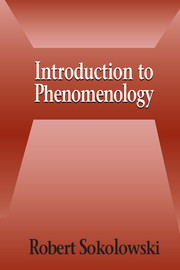Book contents
- Frontmatter
- Contents
- Acknowledgments
- Introduction
- 1 What Is Intentionality, and Why Is It Important?
- 2 Perception of a Cube as a Paradigm of Conscious Experience
- 3 Three Formal Structures in Phenomenology
- 4 An Initial Statement of What Phenomenology Is
- 5 Perception, Memory, and Imagination
- 6 Words, Pictures, and Symbols
- 7 Categorial Intentions and Objects
- 8 Phenomenology of the Self
- 9 Temporality
- 10 The Life World and Intersubjectivity
- 11 Reason, Truth, and Evidence
- 12 Eidetic Intuition
- 13 Phenomenology Defined
- 14 Phenomenology in the Present Historical Context
- Appendix: Phenomenology in the Last One Hundred Years
- Select Bibliography
- Index
Appendix: Phenomenology in the Last One Hundred Years
Published online by Cambridge University Press: 05 June 2012
- Frontmatter
- Contents
- Acknowledgments
- Introduction
- 1 What Is Intentionality, and Why Is It Important?
- 2 Perception of a Cube as a Paradigm of Conscious Experience
- 3 Three Formal Structures in Phenomenology
- 4 An Initial Statement of What Phenomenology Is
- 5 Perception, Memory, and Imagination
- 6 Words, Pictures, and Symbols
- 7 Categorial Intentions and Objects
- 8 Phenomenology of the Self
- 9 Temporality
- 10 The Life World and Intersubjectivity
- 11 Reason, Truth, and Evidence
- 12 Eidetic Intuition
- 13 Phenomenology Defined
- 14 Phenomenology in the Present Historical Context
- Appendix: Phenomenology in the Last One Hundred Years
- Select Bibliography
- Index
Summary
THE BEGINNINGS OF THE MOVEMENT: HUSSERL
The phenomenological movement fits very neatly, almost exactly, into the twentieth century. The work that is generally considered to be the first true phenomenological work, Edmund Husserl's Logical Investigations, appeared in two parts in the years 1900 and 1901, so the new movement began precisely with the dawning of the century. Moreover, this date was literally a new beginning, because Husserl was so truly an original philosopher. He cannot be considered as continuing a tradition that had taken shape before him; even Martin Heidegger, as strong a philosopher as he was, can be understood only in the tradition opened up by Husserl, but Husserl did not have any such overshadowing predecessors. He drew on the work of Franz Brentano and the psychologist Carl Stumpf, but he greatly exceeded them. His theory of intentionality, for example, is far superior to that of Brentano. Husserl's written work before 1900 (his Philosophy of Arithmetic, which appeared in 1891, and the few essays that followed the book), although it foreshadows some of his later thought, is justly considered to be prephenomenological, in the way that Kant's writings before the Inaugural Dissertation of 1770 are taken to be precritical. So now, as we stand at the end of the twentieth century, we can look back at the philosophical movement that began in the year 1900 and attempt to survey it.
Husserl had been a Privatdozent at the University of Halle for fourteen years when, because of the success of Logical Investigations, he was invited to become professor at Göttingen.
- Type
- Chapter
- Information
- Introduction to Phenomenology , pp. 211 - 227Publisher: Cambridge University PressPrint publication year: 1999



